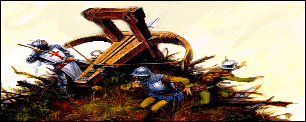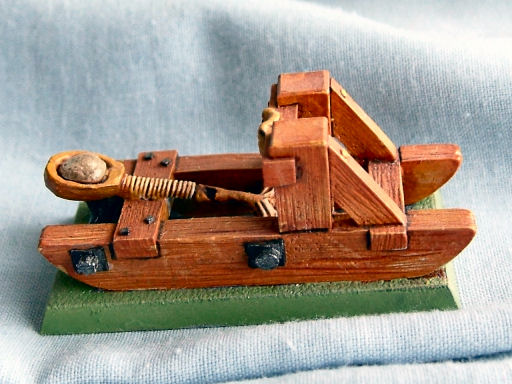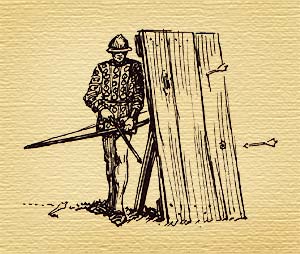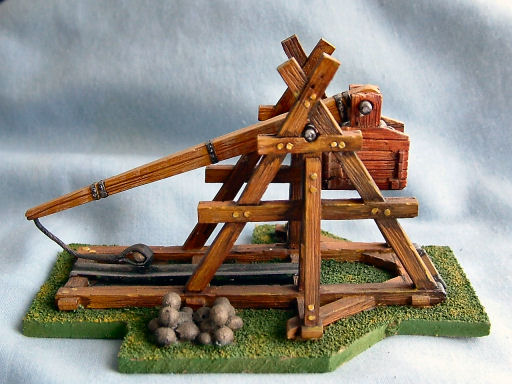|
|
|
|
|
|
|
|
|
|
|
|
|
|
|
|
|
|
Occasionally the need to
handle various siege equipment && artillery will arise.
While the
conduct of large scale battles is not a subject for this work,
the 1:1 use of such machines
can be dealt with easily herein.

<resize table, keeping
8point for fractions>
<there should be UA 'minis', at the
descriptions>
<also, have a portability note?>
<eg. cart6 might = if you have a cart,
then you can move this piece at 6>
<remember, some of these were historically
assembled on-site, by carpenters, overseen by engineers>
Q: How far can three
bozak draconian
(which are described in
the
by Skip Williams
DRAGONLANCE® Adventures
book)
be hurled from a catapult
if they
were bound together and
had their
wings amputated? What would
be
the range if they were launched
singly? Would the ranges
for other
draconians be similar?
A, Catapulted draconians:
Light catapults
hurl rocks that weigh 8-10
lbs. Heavy
catapults hurl rocks that
weigh 20-25 lbs.
Even a single draconian
of any species
placed on a catapult would
overload the
machine so much that the
catapult
wouldn't fire at all. Trebuchets,
however,
have a much larger load
capacity, hurling
rocks that weight about
500 lbs., which is
probably about right for
three draconians.
Rocks, however, are a bit
more aerodynamic
than any three wingless
draconians tied together,
so a draconian-firing trebuchet's
range should be
halved, for a max. range
of 240 yards and a min.
range of 120 yards.
A single draconian fired
from a trebuchet
is grossly underweight as
well as
unaerodynamic, producing
an effect akin
to trying to hurl a slightly
underinflated
beach ball. Use-the scatter
diagram on
page 63 of the 2nd Edition
DMG. Treat the
point labeled ?intended
target? as the
trebuchet; a roll of 1 indicates
that the
draconian is hurled straight
up into the air
and lands right on the trebuchet
(or on top
of its operators, at the
DM?s option). Any
other roll indicates that
the draconian flies
wildly off in the given
direction. Roll
8d4 × 10 for the total
distance in yards
that the draconian ?flies.?
(156.55)

Range Damage <Damage (HP.M)><link to main HP.M explanation> Crew
| Engine or Device | Cost in G.P. | FOF | Min. | Max. | S-M | L | Wood | Earth | Stone, Soft | Rock, Hard | Rate of Fire | Min. | Max. | <MHP> |
| Ballista (or mangonel or scorpion) | 75 | 45° | 1/4" | 32" | 2-12 | 3-18 | - | - | - | - | 1/4-1/2 | 2 | 4 | 2 |
| Catapult, heavy | 200 | 15° | 18" | 36" | 2-24 | 4-16 | 6 | - | 4 | 2 | 1/4 | 6 | 10 | 6 |
| Catapult, light (onager) | 150 | 30° | 15" | 30" | 2-20 | 3-12 | 4 | - | 2 | 1 | 1/4 | 4 | 6 | 4 |
| Cauldron, suspended | 50 | n/a | n/a | n/a | n/a | n/a | - | - | - | - | n/a | n/a | n/a | 2 |
| Gallery, covered (or tortoise) | 350 | n/a | n/a | n/a | n/a | n/a | - | - | - | - | n/a | n/a | n/a | 10 |
| Hoist | 150 | n/a | n/a | n/a | n/a | n/a | - | - | - | - | n/a | n/a | n/a | 4 |
| Mantlet, movable | 15 | n/a | n/a | n/a | n/a | n/a | - | - | - | - | n/a | n/a | n/a | 3 |
| Ram* | 500 | n/a | 0" | 1/4" | 9-16 | 7-12 | 1 @ | - | 1/4 @ | - | 1/2 | 10 | 20 | 12 |
| Ram catcher | 20 | n/a | n/a | n/a | n/a | n/a | - | - | - | - | n/a | n/a | n/a | ? |
| Siege tower | 800 | n/a | n/a | n/a | n/a | n/a | - | - | - | - | n/a | n/a | n/a | 16 |
| Sow (pick or screw)* | 500 | n/a | 0" | 1/4" | 9-16 | 13-24 | 1/2 @ | 1/2 @@@ | 1/2 @ | 1/4 @ | 1/2 | 10 | 20 | 12 |
| Trebuchet | 500 | 10° | 24" | 48" | 3-30 | 5-20 | 8 | - | 5 | 3 | 1/4 | 8 | 12 | 8 |
<add MHP to the above table>
<
COST IN G.P. =
FIELD OF FIRE =
RANGE.MIN =
RANGE.MAX =
DAMAGE.S-M =
DAMAGE.L =
DAMAGE.MHP.WOOD =
DAMAGE.MHP.EARTH =
DAMAGE.MHP.STONE(SOFT) =
DAMAGE.MHP.ROCK(HARD) =
RATE OF FIRE =
CREW.MIN =
CREW.MAX =
MHP =
>
* Damage possible only if victim is directly in front of the boom device (ram, pick, or screw).
<theory: add the cost of a large wagon (150 gp) + 2 draft horses (60 gp for both) + 2 harnesses (24 sp) = total 211 gp & 4 sp, to some of the above>
<theory: a ballista doesn't need a cart (or wagon), although both will help. a ballista moves at 6 over normal terrain, and at 0 over rugged terrain>
<here are the movement
rates for siege engines, from DMGR2.100:
ballista = 6"
catapult, light = 4"
catapult, heavy = 2"
trebuchet = nil
for all of the above, I would
assume a move of 0" in Rugged terrain
>
Field Of {Fire}: The arc of fire of missile engines is as follows:
Intervening objects will
not be likely to interfere with the flight of arched
missiles from catapults
or trebuchets, unless they impose themselves near
the engine or the target.
Thus, a trebuchet could arch its missile over o 40'
high wall which was more
than 6" distant from it and less than 6" from the
target. As ballista missiles
are on a flat trajectory, objects between the
engine and the target will
interrupt the flight path of these missiles.
Use the tables [above] to determine "to hit" probabilities whenever siege engined war machines fire.
Range
is the distance from engine to target creature. The trajectory of
ballista missiles is basically
a flat one, while those from catapults and
trebuchets have a high arch.
Minimum range basically reflects arching
trajectory. The range for
rams and sows is only the maximum swing of the
boom and indicates the proximity
of the engine housing to target
(normally a construction).
Damage variable is self-explanatory.
Rate of fire can be achieved only with at least a minimum crew.
If less
than the minimum number
of crewmen are available, then rate of fire
drops to at best 50% of
normol. The maximum number of crew enables o
ballista to double its normal
rate of fire. All other engines gain nothing
(except less chance of dropping
below minimum requirements for normal
rate of fire) by having
crew above minimum numbers shown.
<Mega Hit Points
: formerly, DPV : Defensive Point Values. This info was moved from Siege
Engines and Devices of War Defensive Values.>
<link to main HP.M explanation>
<This is how many HP.M the siege engine
or war device has.>
<The numbers are
in the brown color that represents wood.>
<In other words, siege engines and devices of war all have HP.M.W>
Ballista (incl. Mangonel, Scorpion):

A war engine which fires
a heavy, spear-like missile. <^Stats^>
The cost of missiles for
a ballista is comparable to javelin
cost. <(10 sp)>
COST
IN G.P. = 75
FIELD
OF FIRE = 45°
RANGE.MIN
= 1/4"
RANGE.MAX
= 32"
DAMAGE.S-M
= 2-12
DAMAGE.L
= 3-18
DAMAGE.MHP.WOOD
= -
DAMAGE.MHP.EARTH
= -
DAMAGE.MHP.STONE(SOFT)
= -
DAMAGE.MHP.ROCK(HARD)
= -
RATE
OF FIRE = 1/4-1/2
CREW.MIN
= 2
CREW.MAX
= 4
MHP =
2
Dragon #254
Catapult:
An engine operating by tension or torsion which hurls heavy missiles. <^Stats^>
Combustibles, rocks, dead
animals, barrels of sewage, etc. can be used as ammunition.

A huge
iron pot for boiling or flaming liquid. <^Stats^>
It is suspended in such
a manner so as to allow it to be tipped easily in order to
spill its contents on attackers.
Gallery,
covered: A sometimes movable construction, typically a heavy timber
frame, with green hides protecting the wood. <^Stats^>
It has a double roof, one
peaked to shed missiles and liquids. It is used to provide cover for attackers
operating against a wall.
Width is 12', height 12',
length 20'.
Hoist: A frame with fulcrum and lever, the lever equipped at one end with a basket which can hoist up to 4 attackers to a height of 30' to assault a construction. <^Stats^>

A wooden wall, with wheels
for movability, and a slit for archery. <^Stats^>
It is typically 6' wide,
8' long, and several inches thick. The mantlet is slanted backward at a
slight angle.
COST
IN GP = 15
MHP:
3
<find an image with wheels
and slit>
<assume 90% cover (+10
AC bonus) for those firing from behind the mantlet>
A movable gallery equipped
with a heavy log suspended from two roof beams by chains. <^Stats^>
The log is shod in iron
and used to batter through defenses.
@ Damage
shown <(in HP.M)> is per round of attack by this mode. <remove references
to HP.M>
Ram
catcher: A fork or hook of iron on a long pole. <^Stats^>
It is lowered by defenders
to catch and hold a ram (or sow) at work on a wall. The defenders then
raise the catcher to disable or break the ram.
A mobile wooden tower, typically
a beam frame with slats and green hides to protect it from fire.
<^Stats^>
It is 16'square at the base,
40' high, with a 10' square parapet at the top. At 30' height there is
a drawbridge 10'
square. The lower portion
is for locomotion. A ladder leads up the back or
interior to drawbridge deck
and the upper parapet, with two intermediate
floors.
COST IN G.P. = 800
FIELD OF FIRE = n/a
RANGE.MIN = n/a
RANGE.MAX = n/a
DAMAGE.S-M = n/a
DAMAGE.L = n/a
DAMAGE.MHP.WOOD = -
DAMAGE.MHP.EARTH = -
DAMAGE.MHP.STONE(SOFT) =
-
DAMAGE.MHP.ROCK(HARD) =
-
RATE OF FIRE = n/a
CREW.MIN = n/a
CREW.MAX = n/a
MHP = 16
-
A pick/screw device, otherwise conforming to the ram, for use against stonework. <^Stats^>
COST IN G.P. = 500
FIELD OF FIRE = n/a
RANGE.MIN = 0"
RANGE.MAX = 1/4"
DAMAGE.S-M = 9-16
DAMAGE.L = 13-24
DAMAGE.MHP.WOOD = 1/2
@
DAMAGE.MHP.EARTH = 1/2
@@@
DAMAGE.MHP.STONE(SOFT) =
1/2
@
DAMAGE.MHP.ROCK(HARD) =
1/4
@
RATE OF FIRE = 1/2
CREW.MIN = 10
CREW.MAX = 20
MHP = 12
@ Damage
shown <(in HP.M)> is per round of attack by this mode.
@@@ Damage
inflicted <in HP.M> only if sow is equipped with a screw device.
Trebuchet:
A large siege engine which fires very heavy missile loads a great distance
by means of lever and counterpoise. <^Stats^>

<note: moved FoF pp. 1 up, as you TARGET before ATTACK>
Field Of Fire: The arc of fire of missile engines is as follows:
Ballista
45° left or right
Catapult, heavy
15° left or right
Catapult, light
30° left or right
Trebuchet
10° left or right
Intervening objects will
not be likely to interfere with the flight of arched
missiles from catapults
or trebuchets, unless they impose themselves near
the engine or the target.
Thus, a trebuchet could arch its missile over a 40'
high wall which was more
than 6" distant from it and less than 6" from the
target. As ballista missiles
are on a flat trajectory, objects between the
engine and the target will
interrupt the flight path of these missiles.

Artillerists must operate
all missile engines in order to allow them a
chance to hit. (You may,
at your option, allow fighters to opt to learn
various artillery engines
in lieu of normal hand weapons.) The level of the
crew chief determines the
chance "to hit", i.e. if a 0 level fighter, then the
first column, if a 1st or
2nd level then the second level, etc. ALL TARGETS,
REGARDLESS OF ACTUAL ARMOR
CLASS, ARE CONSIDERED AS AC 0 FOR
PURPOSES OF "TO HIT" DETERMINATION,
EXCEPT BALLISTA TARGETS
WHICH ARE ALWAYS CONSIDERED
TO BE AC 10 IF EXPOSED TO SIGHT. If a
direct hit is scored, determine
damage according to target size.
I. Direct
Fire Machines:
ballista
mangonels
scorpions
II. Indirect
Fire Machines:
catapults
onagers
trebuchet
Adjust the base number "to
hit" by using the following tables of modifiers.
<A>
Roll d20,
and if the number equals
or exceeds the adjusted base number <(A+B+C+D+E+F)>, a hit has been
scored.
<B>
| Target Movement: | Bonuses and Penalties |
| Stationary | +3 |
| Movement rate less than 3" | 0 |
| Movement rate 3"-12" | -3 |
<C>
| Target Size: | Bonuses and Penalties |
| Man size or smaller | -2 |
| Horse and rider size or small ship size | 0 |
| Giant size, small building or medium ship size | +2 |
| Medium building or large ship size | +4 |
| Large building, castle wall, etc. | +6 |
| Subsequent
shots after initial target shot
(only if target is stationary) |
+4 |
<D>
| Weather Conditions (Ships only) | Bonuses and Penalties |
| Calm | +1 |
| Light to moderate breeze | 0 |
| Strong breeze to strong gale | -2 |
| Storm | -4 |
<E>
| Type of Fire | Bonus |
| Direct Fire | +4 |
If a catapult or trebuchet
miss occurs, go to the GRENADE-LIKE MISSILES
section to find where the
missile struck. Misses will always pass over, to
the left, to the right,
or fall short of the closest appropriate part of the
target, even if this causes
the missile to fall short or exceed the minimum
or maximum range restrictions.
As noted in the GRENADE-LIKE
MISSILES section, missiles from small
catapults are considered
to be of 1' diameter, those from trebuchets 2'.
Ballista missiles are akin
to spears.
<F> <gap between E
and F might be a little bit of a throw-off, at first><can color in capitals
if they are retained>
Cover:
target creatures which can be seen only partially or which are
totally unseen cannot be
hit by catapult or trebuchet missiles in the normal
manner. A target area must
be named and the GRENADE-LIKE MISSILES
determination is then used
to find where the missile actually hits. Ballista
fire is not possible when
target is unseen. If they are partially visible, use
the MISSILE
FIRE COVER AND CONCEALMENT ADJUSTMENTS.
Siege
Damage: The damage caused to constructions by the various
engines, as well as that
caused by various monsters and spells, is detailed
under SIEGE
ATTACK VALUES (q.v.).
SIEGE
ATTACK VALUES <HP.M <Mega Hit Points> By Weapon Type>
Points of <MegaDamage> Against
| Means of Attack | Wood | Earth | Soft Stone | Hard Rock |
| Bigby's Clenched Fist | 1* | - | 1/2* | 1/4* |
| Catapult missile, heavy | 6 | - | 4 | 2 |
| Catapult missile, light | 4 | - | 2 | 1 |
| Dig | - | 10 | - | - |
| Disintegrate | 2 | 2 | 2 | 2 |
| Earth elemental | 2* | 10* | 2* | 1* |
| Earthquake | 5-60 | 5-30 | 5-60 | 5-30 |
| Fireball | 1/2** | - | - | - |
| Giant, cloud, stone, storm | 3* | - | 1* | 1/2* |
| Giant, fire or frost | 2* | - | 1* | 1/2* |
| Giant, hill | 1* | - | 1/2* | 1/4* |
| Giant-hurled boulder -- cloud, fire, or frost | 4 | - | 2 | 1 |
| Giant-hurled boulder -- stone or storm | 6 | - | 4 | 2 |
| Golem, iron | 3* | 1* | 2* | 1* |
| Golem, stone | 3* | 1* | 1* | 1/2* |
| Horn of blasting | 18 | 6 | 8 | 4 |
| Lightning bolt | 1/2** | - | - | - |
| Move earth | - | 20 | - | - |
| Ram | 1* | - | 1/4* | - |
| Sow (pick or screw) | 1/2* | 1/2*** | 1/2* | 1/4* |
| Treant | 8* | 2* | 2* | 1* |
| Trebuchet missile | 8 | - | 5 | 3 |
<size table>
<note: for playability,
it might be easier if the above numbers are multiplied by 4. If so, remem
to adjust all HP.M values of structures, ships, etc.>
<DAMAGE/ATTACK : X-X>
<MEGADAMAGE/ATTACK
: wX, eX, sX, hX>
<megadamage would be an optional [indented] field, like psi should be>
<cut-and-paste from a colored template>
<?? if attack does not affect e(etc.), then drop the e(etc.)>
<spells: insert a damage
row>
*Damage shown is per round of attack by this mode.
**Damage shown is per level
of the spell caster employing the spell,
and assumes fire damage
following if the wooden target is protected by green hides, is wet, etc.,
reduce damage by 50%.
***Damage inflicted only if sow is equipped with a screw device.
Soft
stone includes fired brick, limestone, sandstone.
Hard
rock is granite and similar material.
Mining assumes that
a tunnel will be driven under a construction, shored up, filled with combustibles,
and then fired so as to burn out supports.
If successful, this will
breach a 10' wide section of curtoin wall or cause 10
points of damage to other
sorts of constructions.
Sapping assumes that
workers, under protection of a gallery, for example,
ore able to dig away at
earth or stone. This mode of attack is slow. To
represent it, give it the
damage done by a sow, but on a per turn, rather
than per round, basis.
It is important that the
reoder understond that all values are representative only.
The entire process of siege
warfare would prove interminable in a campaign,
so it has been speeded up
here to force sallies and counter attacking or the fall of the fortress.
There will be times in which
the rules do not cover a specific action that a
player will attempt. In
such situations, instead of being forced to make a
decision, take the option
to allow the dice to control the situation. This can
be done by assigning reasonable
probability to an event and then letting
the player dice to see if
he or she can make that percentage. You can
weigh the dice in any way
so as to give the advantage to either the player
or the non-player character,
whichever seems more correct and logical to
you while being fair to
both sides.
CONSTRUCTION
DEFENSIVE VALUES
<most important: when
everything is done, add the HP.M values to the 'q.construction' (q.building?)
page>
<wait
until all done, then multiply ALL HP.M values by 4>
<HP.M, ie. Megahitponts>
<left here, as a comparison
reference, only>
<edit from final, after
all the Dragon articles are done>
<size>
| Construction | HP.M <formerly: Defensive Point Value> |
| barbican | 150* |
| Bartizan | 25 |
| Batter, plinth, or splay | 20** |
| Battlement | 12 |
| Building, stone (per course) | 10 |
| Building, wood | 8-16 |
| Buttress | 20** |
| Door, iron | 10 |
| Door, wooden | 1 |
| Door, wooden, reinforced | 3 |
| Drawbridge | 10-15 |
| Gate (double reinforced doors) | 8-12 |
| Gatehouse, stone | 120 |
| Hoarding, wooden | 2 |
| Merlon | 10 |
| Palisade, wooden | 6-12 |
| Parapet, stone | 20 |
| Pilaster | 15** |
| Portcullis | 12 |
| Rampart | 20*** |
| Tower, round | 40-80 |
| Tower, square | 30-50 |
| Wall, bastion | 40 |
| Wall, curtain | 20**** |
| Window, shuttered | 4 |
| Window, shuttered & barred | 12 |
* Excludes any values for gates or portcullis.
** All these defensive points
must be destroyed before the construction
supports can be affected,
i.e., a tower with a batter is valued at 20 additional
points.
*** Unaffected by missiles from catapults or from battering or picking.
*** This indicates the strength
of a curtain wall 1 0 ' thick in an area 1 0 '
wide by 10' high; if a breach,
rather than a hole, is desired, the wall
must be destroyed from top
to bottom.
<reminder (code) : there
is no such thing as a d11, or a d21.
2d6 is used for an 11 number
spread (ie. 30-40, if it was listed above)>
<reminder (game school)
: if it makes things easier, move the numbers by 1 or 2>
<remember,
the way AD&D is meant to played : if there were 1,000 numbers in the
game - change 10 of them, in favor of playability>
<some would say, change 10 of them, within a margin of 10%>
<the sum of all numbers, bent either way, within 1% : might b a better
xpression of the above>
<you
should be able to get a close bell curve>
SIEGE
ENGINES AND DEVICES OF WAR DEFENSIVE VALUES
<most important: when
everything is done, add the HP.M values to the 'q.siege' page>
<wait
until all done, then multiply ALL HP.M values by 4>
<size>
| Device | HP.M <formerly: Defensive Point Value> |
| Ballista | 2 |
| Cata pultt, heavy | 6 |
| Catapult, light | 4 |
| Cauldron, suspended | 2 |
| Gallery, covered | 10 |
| Hoist | 4 |
| Mantlet, movable | 3 |
| Ram | 12 |
| Siege Tower | 16 |
| Saw | 12 |
| Trebuchet | 8 |
*template***template*